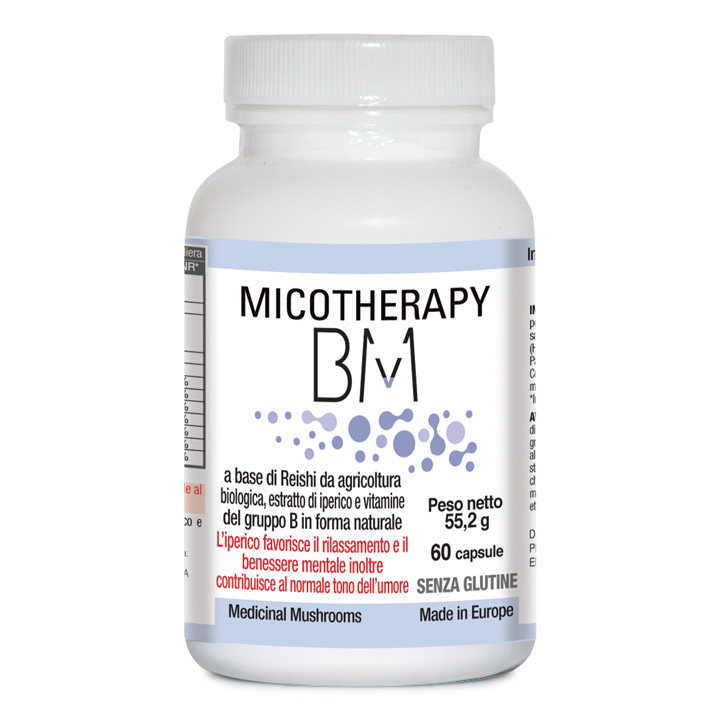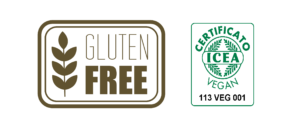
Riequilibrante psico-fisico
Integratore alimentare a base di Reishi da coltivazione biologica, estratti di piante e vitamine del gruppo B in forma naturale
Finalità Salutistiche:
a base di estratto secco di Reishi da agricoltura biologica, Micotherapy BM svolge una naturale azione calmante, attenuando in modo naturale gli stati d’ansia. Grazie all’azione sinergica dei suoi componenti aiuta a migliorare la qualità del sonno e la capacità di gestire lo stress psicofisico, contribuendo a fornire una maggiore lucidità mentale
Ingredienti:
- Reishi (Ganoderma lucidum) estratto secco tit. 25% polisaccaridi
- Complesso vegetale di vitamine del gruppo B da grano saraceno
- Iperico erba estr. secco (tit. 0,3% ipericina)
- Passiflora fiori estr. secco (tit. 3,5% flavonoidi)
- Centella foglie estr. secco (tit. 40% triterpeni)
- Capsula in cellulosa vegetale
Proprietà dei componenti:
Reishi: chiamato anche “fungo dei mille anni” o “fungo dell’immortalità perché si ritiene favorisca la longevità il Reishi è considerato tradizionalmente un rimedio in grado di ripristinare l’equilibrio dell’organismo migliorando la resistenza alle malattie. Inoltre agisce sul sistema nervoso e sul rilascio di endorfine endogene svolgendo una naturale azione calmante, migliora la qualità del sonno e la capacità di recupero dell’organismo.
Iperico estratto secco: favorisce il rilassamento e il benessere mentale, contribuendo al normale tono dell’umore, viene comunemente utilizzato in situazioni di depressione lieve o moderata, accompagnata da ansia, stanchezza, perdita dell’appetito e alterazioni del sonno.
Passiflora: presenta azione calmante e sedativa sul sistema nervoso centrale, con effetti importanti in situazioni di stress, nervosismo e insonnia.
Centella: svolge un’azione antinfiammatoria e aumenta l’ossigenazione cerebrale migliorando la lucidità mentale, la concentrazione e i ritmi del sonno.
Vitamine del gruppo B in forma naturale: altamente biodisponibili, sono importanti nel mantenimento dell’equilibrio e nella protezione del sistema nervoso, sia dal punto di vista strutturale che funzionale.
Modalità d’uso:
2-4 capsule al giorno
Formato:
confezione da 60 capsule
Note:

inserito nel registro degli integratori: codice 71757
Codice Paraf: A925603779
| Tenore medio degli ingredienti | per dose giornaliera (2 cps) | RDA |
| Reishi estr. secco | 660 mg | |
| Apporto in polisaccaridi | 165 mg | |
| Grano saraceno | 400 mg | |
| Iperico estr. secco | 235 mg | |
| Apporto giornaliero di Ipericina | 0,7 mg | |
| Rapporto iperforine/ipericina | non superiore a 7 | |
| Passiflora estr. secco | 200 mg | |
| Centella estr. secco | 100 mg | |
| Vitamina B1 (tiamina) | 0,8 mg | 73% |
| Vitamina B2 (riboflavina) | 1,3 mg | 93% |
| Vitamina B3 (niacina) | 14,3 mg | 89% |
| Vitamina B5 (ac. pantotenico) | 5,5 mg | 91% |
| Vitamina B6 (piridossina) | 0,8 mg | 57% |
| Acido folico | 180 mcg | 90% |
| Vitamina B12 (metilcobalamina) | 1,6 mcg | 64 % |
Bibliografia:
- Mizuno, T. (1996). Oriental Medicinal tradition of “Ganoderma lucidum (Reishi)” in China. In T. Mizuno & B.-K. Kim(Eds.), Ganoderma lucidum (pp. 101-106). Seoul, Korea : IlYang Pharm. Co. Ltd
- Kim KC, Kim IG. Ganoderma lucidum extract protects DNA from strand breakage caused by hydroxyl radical and UV irradiation.Int J Mol Med 1999 Sep;4(3):273-7
- Wachtel-Galor S, Szeto YT, Tomlinson B, et al. Ganoderma lucidum (‘Lingzhi’); acute and short-term biomarker response to supplementation. Int J Food Sci Nutr. Feb 2004;55(1):75-83
- T.A. Ajith, N.P. Sudheesh, D. Roshny, G. Abishek and K.K. Janardhanan. Effect of Ganoderma lucidum on the activities of mitochondrial dehydrogenases and complex I and II of electron transport chain in the brain of aged rats Experimental Gerontology Volume 44, Issue 3, March 2009, Pages 219-223
- Tang W, Gao Y, Chen G, et al. A Randomized, Double-Blind and Placebo-Controlled Study of a Ganoderma lucidum Polysaccharide Extract in Neurasthenia. J Med Food. 2005;8:53-58
- CS Lai, MS Yu, WH Yuen, KF So, SY Zee, and RC Chang. Antagonizing beta-amyloid peptide neurotoxicity of the anti-aging fungus Ganoderma lucidum. Brain Res, Jan 2008; 1190: 215-24
- R Zhang, S Xu, Y Cai, M Zhou, X Zuo and P Chan. Ganoderma lucidum Protects Dopaminergic Neuron Degeneration Through Inhibition of Microglial Activation. eCAM Advance Access published July 16, 2009
- ZY Zhou, YP Tang, J Xiang, P Wua, HM Jin, Z Wang, M Mori, and DF Cai. Neuroprotective effects of water-soluble Ganoderma lucidum polysaccharides on cerebral ischemic injury in rats. J Ethnopharmacol, August 19, 2010; 131(1): 154-64
- Zhou Y, Qu ZQ, Zeng YS, Lin YK, Li Y, Chung P, Wong R, Hagg U. Neuroprotective effect of preadministration with Ganoderma lucidum spore on rat hippocampus. Exp Toxicol Pathol, November 1, 2012; 64(7-8): 673-80
- Ajith TA et al. Effect of Ganoderma lucidum on the activities of mitochondrial dehydrogenases and complex I and II of electron transport chain in the brain of aged rats. ExpGerontol 2009; 44(3):219-223
- Ding H, et al. Ganoderma lucidum extract protects dopaminergic neurons through inhibiting the production of inflammatory mediators by activated microglia. Sheng Li Xue Bao. 2010 Dec 25;62(6):547-54
- Zhao HB, et al. Polysaccharide extract isolated from ganoderma lucidum protects rat cerebral cortical neurons from hypoxia/reoxygenation injury. J Pharmacol Sci. 2004 Jun;95(2):294-8
- Zhang R, et al. Ganoderma lucidum protects dopaminergic neuron degeneration through inhibition of microglial activation. Evid Based Complement Alternat Med. 2011;2011:156810
- Chen LW, Horng LY, Wu CL, Sung HC, Wu RT. Activating mitochondrial regulator PGC-1alpha expression by astrocytic NGF is a therapeutic strategy for Huntington’s disease. Neuropharmacology. 2012 May 24
- XY Cui, SY Cui, J Zhang, ZJ Wang, B Yu, ZF Sheng, XQ Zhang, and YH Zhang Extract of Ganoderma lucidum prolongs sleep time in rats. J Ethnopharmacol, February 15, 2012; 139(3): 796-800
- Lee JM et al. Inhibition of lipid peroxidation and oxidative DNA damage by Ganoderma lucidum. Phytotherapy Res; 15: 245-249
- Campanini E. – “ Dizionario di fitoterapia e piante medicinali”– Milano, 2012
- Fassina G. – “Lezioni di farmacologia”- Cedam, Padova, 1995
- Speroni E. et al. Neuropharmacological activity of extracts from Passiflora incarnata. Planta Med. 54, 488-491, 1988
- Bourin A.V. et al. A combination of plant extracts in the treatment of outpatients with adjustement disorders with anxious mood. Controlled study versus placebo. Fundam. Clin. Pharmacol. 11, 127-132, 1997
- Speroni E. et al. Role of chrisin in the sedative effects of Passiflora incarnata L. Phytother. Res. 10, suppl. 1, S 98- S 100, 1996
- Speroni E. et al. Sedative effects of crude extracts of Passiflora incarnata after oral administration. Phytother. Res. 10, suppl. 1, S 92-S 94, 1996
- Dhawan K. et al. Anxiolytic activity of aerial and underground parts of Passiflora incarnata. Fitoterapia 72, 922-926, 2001
- Dhawan K. et al. Anti-anxiety studies on extracts of Passiflora incarnata Linneaus. J. Ethnopharmacol. 78, 165-170, 2001
- Akhondzadek S. et al. Passionflower in the treatment of generalized anxiety: a pilot double blind randomized controlled trial with oxazepam. J. Clin. Pharm. Ther. 26, 363-377, 2001
- Dhawan K. et al. Comparative Anxiolytic Activity Profile of Various Preparations of Passiflora incarnata Linneaus: A Comment on Medicinal Plants’ Standardization. J Altern Complement Med 8(3):283-91, 2002
- A Szegedi, R Kohnen, A Dienel, M Kieser. Acute treatment of moderate to severe depression with hypericum extract WS 5570 (St John’s wort): randomised controlled double blind non-inferiority trial versus paroxetine. BMJ 2005;330:503
- Monograph. Hypericum perforatum. Altern Med Rev. 2004 Sep; 9 (3):318-25
- Linde K, Mulrow CD, Berner M, Egger M. St John’s worth for depression. Cochrane Database Syst Rev. 2005 Apr 18;(2):CD000448
- James, J.T.; Dubery, I.A. Pentacyclic Triterpenoids from the Medicinal Herb, Centella asiatica (L.) Urban. Molecules 2009, 14, 3922-3941
- Blumenthal M et al. The Complete German Commission E Monographs: Therapeutic Guide to Herbal Medicines. Klein S, Rister RS, translators. Austin (TX): American Botanical Council; Boston (MA): Integrative Medicine Communications; 1998
per ulteriori informazioni visitate il sito: www.micotherapy.it




